Natto Varieties and Creative Pairings for Every Meal
Dec 17,2020
Natto Varieties and Creative Pairings for Every Meal
Dec 17,2020
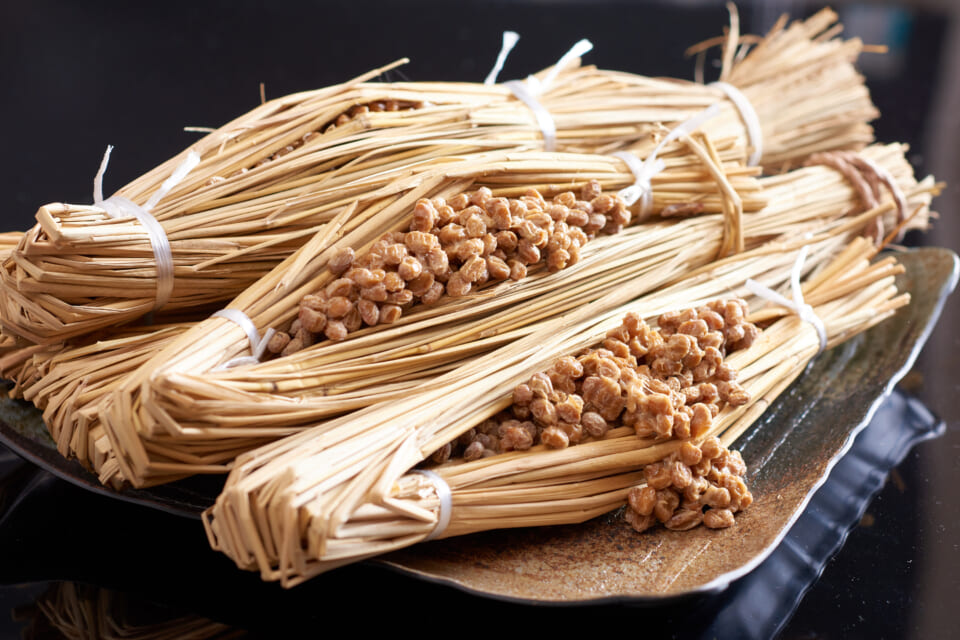

Natto — fermented soybeans — has long been a constant on Japan’s dining tables.
Natto is a fermented superfood that has been called the best of both worlds because, in addition to the excellent nutritional value of its Bacillus subtilis var. natto, nattokinase enzyme, and other nutrients, it supposedly provides beauty benefits from the isoflavones and dietary fiber contained in natto’s soybeans.
For this article, Noro Takehiro, chairman of the Japan Natto Cooperative Society Federation, shared his vast knowledge on how to enjoy a fulfilling natto life.
The Japan Natto Cooperative Society Federation (Nattoren) was founded in 1954 by businesses involved in natto production as an industry organization to promote the benefits of natto and add value to natto products, with the aim of passing on natto culture and expanding the industry.
Nattoren holds an annual Natto Contest to encourage innovation in processing and manufacturing techniques and further enhance the quality of natto. Judges evaluate natto on three metrics — (visual) appearance, aroma, and taste and texture — to determine the best natto in Japan.
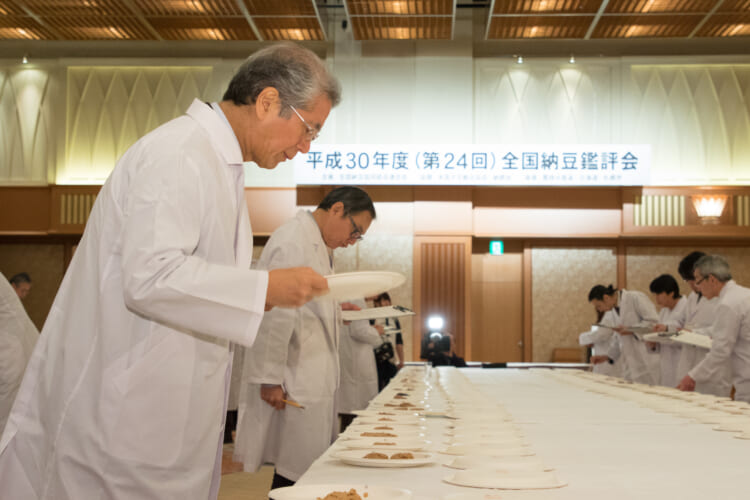
Scene from a past national Natto Contest
“When tasting natto as an individual, the most important thing is your own preferences. Some people find natto with strong acidic tastes to be delicious, while others favor natto that has been fermented further and has a more distinctive smell. I encourage everyone to find their own best-in-Japan natto.”
Nearly 200 types of natto are entered in the Natto Contest each year, indicating just how many types of natto exist around the country.
“Natto is first of all classified by the soybean size: large, medium, small, extra small, and hikiwari, a type of natto where the soybeans are crushed into small bits. The next difference is the seasoning, which depends on the accompanying sauce. Because natto cannot be flavored during the fermentation process, manufacturers have devised a wide variety of sauces to make their products more appealing to more people.”
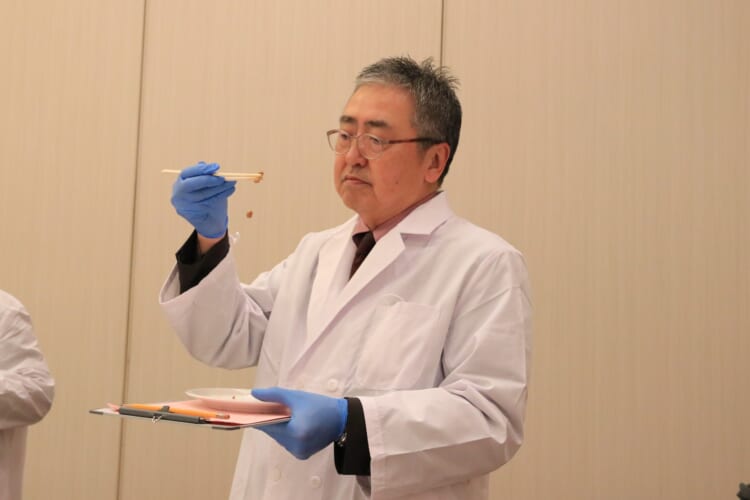
Noro Takehiro, chairman of the Japan Natto Cooperative Society Federation, evaluates a natto entry
Noro recommends that people try local natto varieties or a novelty variety when they want to eat a slightly different type of natto.
Local natto delicacies from around the country and novelty varieties
— Dried natto (Kumamoto)
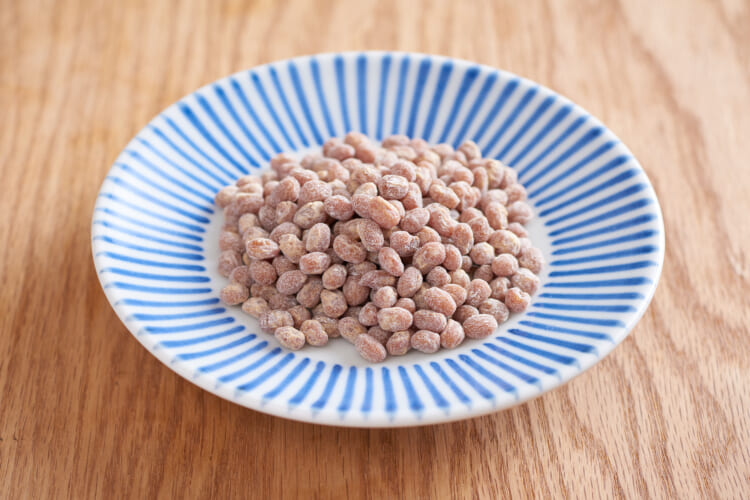
Dried natto is a traditional dish in Kumamoto. This preserve is made by mixing salt and flour or rice flour with natto and drying it in the sun on a clear, dry day. Locals call it korumame and eat it regularly as a snack served with tea or as a between-meal treat.
— Soboro natto (Ibaraki)
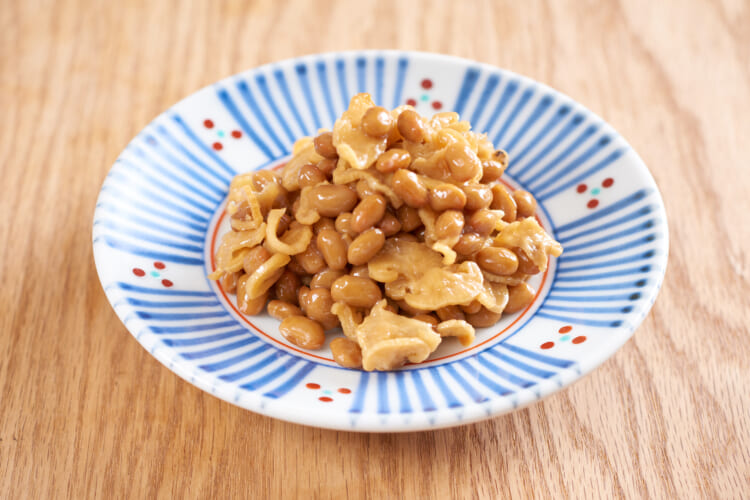
Soboro natto is a kind of side dish in which reconstituted dried chopped daikon radish is added to natto and then seasoned and pickled with soy sauce or other seasonings. The crunchiness of the dried chopped daikon radish plus the clinginess of the natto makes for an addictive taste.
— Tera natto (Kyoto and Shizuoka)
Tera natto [literally temple natto] is made by sprinkling flour on steamed soybeans, fermenting them with koji malt, and then drying them in the sun. The name comes from the fact that the dish was traditionally made at temples. Famous examples include Daitoku-ji natto in Kyoto and Daifuku-ji natto in Shizuoka, both named after temples. Tera natto is also called hama natto [beach natto].
— Freeze-dried natto
This natto, which is freeze-dried in a vacuum, has an appealing crunchy texture that upends the conventional notions of natto. Freeze-dried natto can be eaten as is or added to pasta or miso soup, making it an easy way to benefit from natto’s nutritional goodness.
To avoid getting tired of natto, try experimenting with different ways to eat it. Local natto dishes from various regions contain many hints of ways to savor natto.
Noro classifies local natto dishes into traditional and modern types and gave us some typical examples of each.
Traditional types
— Natto soup

Courtesy of Japan’s Ministry of Agriculture, Forestry and Fisheries website
Natto soup is a miso soup variant with natto added to a hearty miso soup packed with vegetables, deep-fried tofu, tofu, mushrooms, wild edible plants, and other ingredients. This dish has long been eaten in snowy regions like Yamagata and Akita that have extremely cold winters. The thickening the natto provides to the miso soup prevents the heat from escaping, and every sip warms the body from the inside out.
— Natto mochi [rice cake]
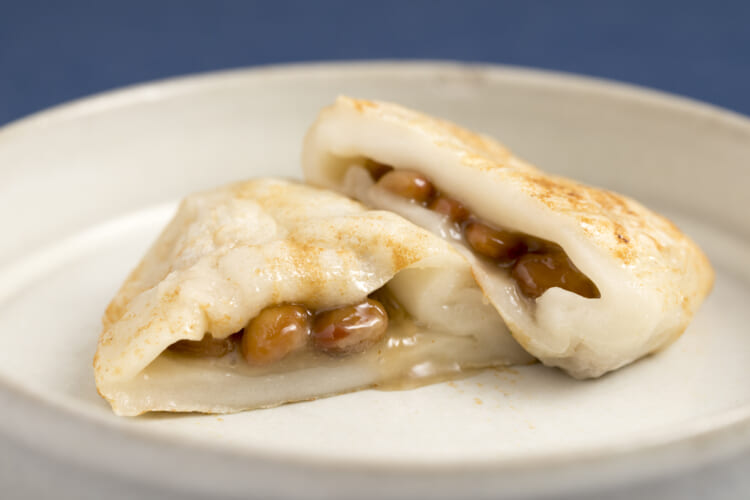
Courtesy of Japan’s Ministry of Agriculture, Forestry and Fisheries website
Natto mochi, a Kyoto delicacy, is a filling dish made by stuffing the middle of a mochi rice cake with natto and then baking it. In antiquity, natto was presented at the Kyoto Imperial Palace as a rare luxury, so the common people came to consider natto as a precious item to be eaten on festive occasions. Even though the custom of making natto at home has almost disappeared, people still follow the tradition of eating natto mochi during the first three days of the New Year.
Modern types
— Milk natto chazuke
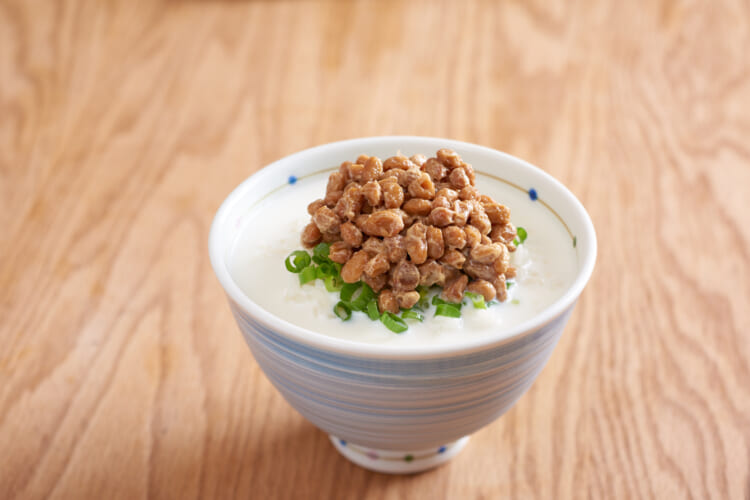
Milk natto chazuke was developed in Furano, Hokkaido. Chazuke normally refers to a dish where green tea is poured over rice. But in this case, fresh milk from Furano is heated and poured over rice sprinkled with green onions, which is then topped with natto and seasoned with special soy sauce. The avant-garde milk natto chazuke was apparently conceived by Kuramoto So, scriptwriter for the Kita no Kuni Kara TV series, which was set in Hokkaido. The creamy milk and natto are a surprisingly good match, and many people have become hooked on them.
In addition to the above dishes, there is a huge variety of local natto dishes, including Okinawa’s natto taco rice, kimchi natto ramen from Morioka, Iwate, and natto with minced meat and rakkyo scallions from the Tottori Sand Dunes region of Tottori.
As with Furano’s milk natto chazuke, natto actually goes very well with dairy products, especially cheeses like Parmesan cheese. Natto tastes outstanding with oils like Chinese chili oil and olive oil. And when stir-fried with meat fat, the smell disappears and even people who don’t like natto can enjoy it.
“Natto has a strong personality and presence, but as an ingredient it goes surprisingly well with nearly everything. Try it in various combinations featuring dairy products and oils.”
Natto-plus recipes recommended by Nattoren and Noro
— Natto plus mayonnaise
Kids love natto and mayo. Just about everyone finds this milder flavor delicious.
— Natto plus olive oil plus tomato

Just drizzle olive oil on natto and mix in some chopped tomatoes for a stylish side dish with a slightly Western flavor.
People looking to eat natto in a more delicious way and trying to consume all its nutrition often have qualms like “How many times should I mix it?” or “When should I eat natto?”
You sometimes find advice like “Natto tastes best after mixing it more than 400 times” or “The more you mix it, the better it tastes.” But what are the actual correct answers?
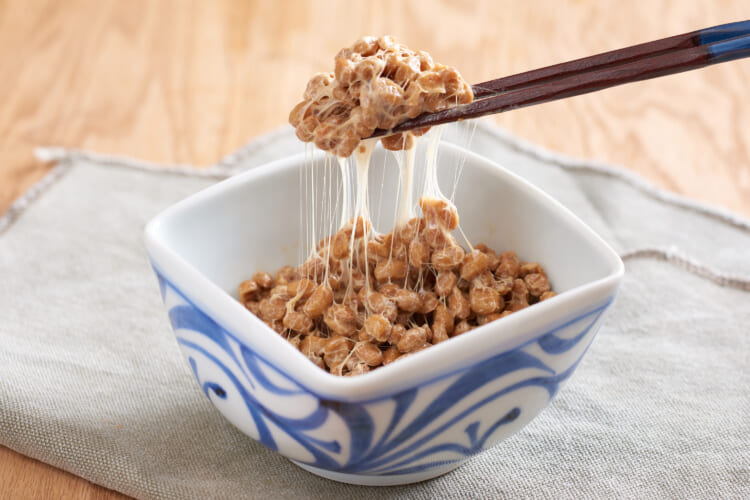
“When people start talking about how to eat natto, everyone gets heated claiming their way is the best. [laughs] In truth, natto is delicious no matter how you eat it. Some people like to eat it without mixing it at all, while others like to mix it a lot, so we don’t have an answer for you at Nattoren. We encourage everyone to show off how attached they are to their style of natto and to stick with the particular way they feel is delicious.”
Chairman Noro demonstrates his own recommended way to eat natto in the video below.
■Class on how to eat natto deliciously
Although natto has an image as a breakfast item, Noro says, “You can eat it anytime, and as long as you don’t eat too much, you can have it as many times a day as you like.” He recommends that you store natto in the freezer when it approaches its best-before date. If the frozen natto is thawed at room temperature, you can enjoy it without losing any of the flavor or nutrients.
But is it safe to assume you can still eat natto even after the best-before date?
“We hear a lot of people say it’s okay to eat natto after its best-before date since it is fermented in the first place. However, we cannot recommend this practice because the flavor and deliciousness will fade. Natto is a traditional fermented food and an indispensable soul food for the Japanese people. We hope everyone continues their natto love and romance and enjoys eating delicious natto every day.”